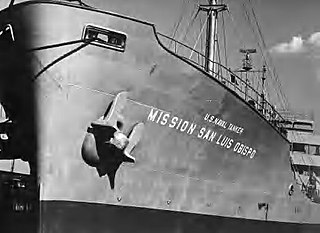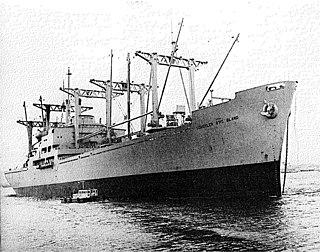
USNS Kingsport (T-AG-164) was built as SS Kingsport Victory, a United States Maritime Commission VC2-S-AP3 (Victory) type cargo ship. During the closing days of World War II the ship was operated by the American Hawaiian Steamship Company under an agreement with the War Shipping Administration. After a period of layup the ship was operated as USAT Kingsport Victory by the Army under bareboat charter effective 8 July 1948. When Army transports were transferred to the Navy's Military Sea Transportation Service the ship continued as USNS Kingsport Victory (T-AK-239), a cargo transport. On 14 November 1961, after conversion into the first satellite communication ship, the ship was renamed Kingsport, reclassified as a general auxiliary, and operated as USNS Kingsport (T-AG-164).

Sea Fighter (FSF-1) is an experimental littoral combat ship in service with the United States Navy. Its hull is of a small-waterplane-area twin-hull (SWATH) design, provides exceptional stability, even on rough seas. The ship can operate in both blue and littoral waters. For power, it can use either its dual gas-turbine engines for speed or its dual diesel engines for efficient cruising. It can be easily reconfigured through the use of interchangeable mission modules. Helicopters can land and launch on its deck. Smaller water craft can be carried and launched from its stern. The vessel is being developed under the program title Littoral Surface Craft-Experimental with a hull type designation Fast Sea Frame. The first vessel has been assigned the hull classification symbol FSF 1 and also has been referred to as the X-Craft. The vessel was designed by British company BMT Nigel Gee Ltd who continue with a role in the development of the vessel.

SS Mission San Luis Obispo was a Type T2-SE-A2 tanker built for the United States Maritime Commission during World War II. After the war she was acquired by the United States Navy as USS Mission San Luis Obispo (AO-127). Later the tanker transferred to the Military Sea Transportation Service as USNS Mission San Luis Obispo (T-AO-127). A Mission Buenaventura-class oiler, she was named for Mission San Luís Obispo de Tolosa in San Luis Obispo, California.

USNS Observation Island (T-AGM-23) was built as the Mariner-class merchant ship Empire State Mariner for the United States Maritime Commission, launched 15 August 1953, and operated by United States Lines upon delivery on 24 February 1954, making voyages for the Military Sea Transportation Service (MSTS) until going into reserve at Mobile, Alabama on 9 November 1954.

Austal USA is an American shipbuilder based on Blakeley Island in Mobile, Alabama. It is a subsidiary of the Australian shipbuilder Austal, operating under a Special Security Arrangement which allows it to work independently and separately on some of the most sensitive United States defense programs despite its foreign ownership.

A high-speed craft (HSC) is a high-speed water vessel for civilian use, also called a fastcraft or fast ferry. The first high-speed craft were often hydrofoils or hovercraft, but in the 1990s catamaran and monohull designs become more popular and large hydrofoils and hovercraft are no longer built. Most high-speed craft serve as passenger ferries, but the largest catamarans and monohulls also carry cars, buses, large trucks and freight.
Hawaii Superferry was a Hawaii-based transportation company that provided passenger and vehicle transportation between Honolulu Harbor on the island of Oʻahu and Kahului Harbor on Maui. Legal issues over environmental impact statements and protests from residents of Maui and Kauaʻi temporarily delayed the implementation of service, but service between Oʻahu and Maui began in December 2007. The company had hoped to return service to Nawiliwili Harbor on Kauaʻi and additionally planned to eventually provide service to Kawaihae Harbor on the Big Island.

Dublin Swift is a high-speed catamaran built in 2001 by Austal as a passenger and vehicle catamaran ferry. After conversion to a Maritime Prepositioning ship the vessel was chartered by the United States Navy's Military Sealift Command until January 2018 as WestPac Express. It was then converted for civilian use as a passenger ferry by Irish Ferries and renamed Dublin Swift.

USS Cohocton (AO-101) was lead ship of her class of fleet oiler acquired by the United States Navy for use during World War II. She had the dangerous but necessary task of providing fuel to vessels in combat and non-combat areas. She served in the Pacific Ocean Theatre of operations late in the war.
USS Alderamin (AK-116) was a Crater-class cargo ship commissioned by the U.S. Navy for service in World War II, named after Alderamin, the alpha star in constellation Cepheus. She was responsible for delivering troops, goods and equipment to locations in the war zone.

USS Adria (AF-30) was an Adria-class stores ship in service with the United States Navy from 1944 to 1954. She was scrapped in 1977.

HST-2, formerly named USNS Puerto Rico and Alakai, is a vessel owned by the United States Navy Military Sealift Command. She was originally Hawaii Superferry's first high-speed ferry. The vessel was later chartered by Bay Ferries Limited to operate a ferry service between Maine and Yarmouth, Nova Scotia.

The HSC Virgen de Coromoto is an 86 m (282 ft) fast catamaran ferry operated by Consolidada de Ferrys C.A. in Venezuela. It was built in Australia in 2004 for a fast ferry service on Lake Ontario between Toronto, Ontario, Canada and Rochester, New York, United States. After the ferry service failed, the boat was sold in 2007 and operated in the Strait of Gibraltar on a Spain-Morocco service until 2012. In 2012–13, the ship operated on Kattegatruten's Aarhus–Kalundborg route in Denmark until October 2013 when the route was cancelled.

Austal Limited is an Australian-based global ship building company and defence prime contractor that specialises in the design, construction and support of defence and commercial vessels. Austal's product range includes naval vessels, high-speed ferries, and supply or crew transfer vessels for offshore windfarms and oil and gas platforms.

The Spearhead-class expeditionary fast transport (EPF) is a United States Navy–led shipbuilding program to provide a high-speed, shallow draft vessel intended for rapid intra-theater transport of medium-sized cargo payloads. The EPFs can reach speeds of 35–45 knots (65–83 km/h; 40–52 mph), and allow the rapid transit and deployment of conventional or special forces, equipment and supplies. The vessels are a part of Military Sealift Command's Sealift Program. The class was previously designated as "Joint High Speed Vessel (JHSV)", and redesignated in September 2015.

USNS Fall River (JHSV-4/T-EPF-4) is the fourth Spearhead-class expeditionary fast transport, which is operated by the United States Navy's Military Sealift Command (MSC). Fall River was built by Austal USA in Mobile, Alabama.

USNS Schuyler Otis Bland also known as SS Schuyler Otis Bland is the only ship of the series C3-S-DX1 (Freedom-class).

USNS Brunswick (JHVS-6/T-EPF-6), is the sixth Spearhead-class expeditionary fast transport, currently in service with the United States Navy's Military Sealift Command. It is the fourth ship in naval service named after Brunswick, Georgia. Brunswick is one of three expeditionary fast transport ships in the U.S. 7th Fleet area of responsibility to continue its mission of providing rapid intra-theater transport of troops and military equipment. Like other EPFs of its class, the Brunswick is capable of carrying up to 600 short tons of equipment for distances of 1,200 nautical miles at an average speed of 35 knots.

USNS Puerto Rico (T-EPF-11) is the eleventh Spearhead-class expeditionary fast transport and currently in service with the United States Navy's Military Sealift Command.


















